Uridine triacetate
Editor-In-Chief: C. Michael Gibson, M.S., M.D. [1]; Associate Editor(s)-in-Chief: Martin Nino [2]
Disclaimer
WikiDoc MAKES NO GUARANTEE OF VALIDITY. WikiDoc is not a professional health care provider, nor is it a suitable replacement for a licensed healthcare provider. WikiDoc is intended to be an educational tool, not a tool for any form of healthcare delivery. The educational content on WikiDoc drug pages is based upon the FDA package insert, National Library of Medicine content and practice guidelines / consensus statements. WikiDoc does not promote the administration of any medication or device that is not consistent with its labeling. Please read our full disclaimer here.
Overview
Uridine triacetate is a pyrimidine analog for uridine replacement that is FDA approved for the treatment of patients with hereditary orotic aciduria. Common adverse reactions include none.
Adult Indications and Dosage
FDA-Labeled Indications and Dosage (Adult)
Indications
Uridine triacetate is indicated for the treatment of hereditary orotic aciduria.
Dosage
- Recommended Dosage
- The recommended starting dosage of oral Uridine triacetate is 60 mg/kg once daily. Increase the dosage of Uridine triacetate to 120 mg/kg (not to exceed 8 grams) once daily for insufficient efficacy, such as occurrence of one of the following:
- Levels of orotic acid in urine remain above normal or increase above the usual or expected range for the patient
- Laboratory values (e.g., red blood cell or white blood cell indices) affected by hereditary orotic aciduria show evidence of worsening
- Worsening of other signs or symptoms of the disease
- The Uridine triacetate dose to be administered at the 60 mg/kg and 120 mg/kg dose levels by body-weight is presented in Tables 1 and 2.
- A 2 gram packet of Uridine triacetate contains approximately ¾ teaspoon of Uridine triacetate. Therefore, in the tables below for patients requiring doses in multiples of 2 grams (¾ teaspoon) an entire packet(s) may be administered without weighing or measuring.
- Uridine triacetate Daily Dose Based on Body Weight (kg)
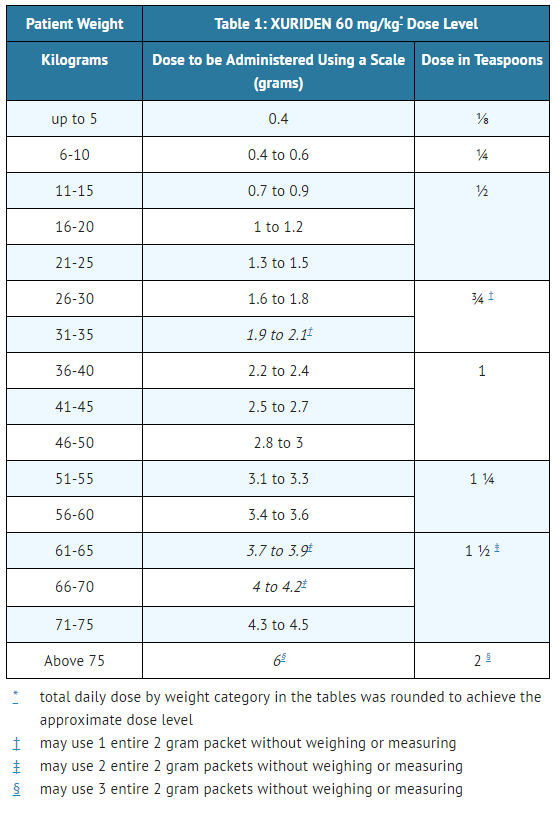
XURIDEN: Uridine triacetate's Brand name

XURIDEN: Uridine triacetate's Brand name
Off-Label Use and Dosage (Adult)
Guideline-Supported Use
There is limited information regarding Off-Label Guideline-Supported Use of Uridine triacetate in adult patients.
Non–Guideline-Supported Use
There is limited information regarding Off-Label Non–Guideline-Supported Use of Uridine triacetate in adult patients.
Pediatric Indications and Dosage
FDA-Labeled Indications and Dosage (Pediatric)
The safety and effectiveness of Uridine triacetate have been established in pediatric patients (same indications and dosage as adults).
Off-Label Use and Dosage (Pediatric)
Guideline-Supported Use
There is limited information regarding Off-Label Guideline-Supported Use of Uridine triacetate in pediatric patients.
Non–Guideline-Supported Use
There is limited information regarding Off-Label Non–Guideline-Supported Use of Uridine triacetate in pediatric patients.
Contraindications
None
Warnings
None
Adverse Reactions
Clinical Trials Experience
Because clinical trials are conducted under widely varying conditions and using a wide range of doses, adverse reaction rates observed in the clinical trials of a drug cannot be directly compared to rates in the clinical trials of another drug and may not reflect the rates observed in practice.
The safety of Uridine triacetate was assessed in 4 patients with hereditary orotic aciduria ranging in age from 3 to 19 years (3 male, 1 female) who received 60 mg/kg of Uridine triacetate once daily for six weeks. The patients continued to receive Uridine triacetate for at least 9 months at dosages of up to 120 mg/kg once daily. No adverse reactions were reported with Uridine triacetate.
Postmarketing Experience
There is limited information regarding Uridine triacetate Postmarketing Experience in the drug label.
Drug Interactions
There is limited information regarding Uridine triacetate Drug Interactions in the drug label.
Use in Specific Populations
Pregnancy
- Risk Summary
- There are no available data on Uridine triacetate use in pregnant women to inform a drug-associated risk. When administered orally to pregnant rats during the period of organogenesis, uridine triacetate at doses similar to the maximum recommended human dose (MRHD) of 120 mg/kg per day was not teratogenic and did not produce adverse effects on embryo-fetal development.
The background risk of major birth defects and miscarriage for the indicated population are unknown. In the U.S. general population, the estimated background risk of major birth defects and miscarriage in clinically recognized pregnancies is 2 to 4% and 15 to 20%, respectively.
- Data
- Animal Data
- In an embryo-fetal development study, uridine triacetate was administered orally to pregnant rats during the period of organogenesis at doses up to 2000 mg/kg per day (about 2.7 times the maximum recommend human dose (MRHD) of 120 mg/kg per day on a body surface area basis). There was no evidence of teratogenicity or harm to the fetus and no effect on maternal body weight and overall health.
Pregnancy Category (AUS):
There is no Australian Drug Evaluation Committee (ADEC) guidance on usage of Uridine triacetate in women who are pregnant.
Labor and Delivery
There is no FDA guidance on use of Uridine triacetate during labor and delivery.
Nursing Mothers
There are no data on the presence of uridine triacetate in human milk, the effect on the breastfed infant or the effect on milk production. The development and health benefits of breastfeeding should be considered along with the mother's clinical need for Uridine triacetate and any potential adverse effects on the breastfed infant from Uridine triacetate or from the underlying maternal condition.
Pediatric Use
The safety and effectiveness of Uridine triacetate have been established in pediatric patients. Use of Uridine triacetate is supported by a single open-label clinical trial of uridine triacetate in 4 patients and a retrospective review of the clinical course of 18 patients with hereditary orotic aciduria who were treated with uridine beginning at ages 2 months to 12 years. There are no apparent differences in clinical response between adults and pediatric patients with hereditary orotic aciduria treated with uridine, however, data are limited.
Geriatic Use
There is no FDA guidance on the use of Uridine triacetate in geriatric settings.
Gender
There is no FDA guidance on the use of Uridine triacetate with respect to specific gender populations.
Race
There is no FDA guidance on the use of Uridine triacetate with respect to specific racial populations.
Renal Impairment
There is no FDA guidance on the use of Uridine triacetate in patients with renal impairment.
Hepatic Impairment
There is no FDA guidance on the use of Uridine triacetate in patients with hepatic impairment.
Females of Reproductive Potential and Males
There is no FDA guidance on the use of Uridine triacetate in women of reproductive potentials and males.
Immunocompromised Patients
There is no FDA guidance one the use of Uridine triacetate in patients who are immunocompromised.
Administration and Monitoring
Administration
- Preparation
Measure the dose using either a scale accurate to at least 0.1 gram, or a graduated teaspoon, accurate to the fraction of the dose to be administered.
Once the measured dose has been removed from the Uridine triacetate packet, discard the unused portion of granules. Do not use any granules left in the open packet.
- Administration with Food
- 1. Place 3 to 4 ounces of applesauce, pudding or yogurt in a small clean container.
- 2. Mix the measured amount of granules in the applesauce, pudding or yogurt
- 3. Swallow applesauce/pudding/yogurt immediately. Do not chew the granules. Do not save the applesauce/pudding/yogurt for later use.
- 4. Drink at least 4 ounces of water.
- Administration in Milk or Infant Formula
Uridine triacetate can be mixed with milk or infant formula instead of the soft foods described above for patients receiving up to 3/4 teaspoon (2 grams) of Uridine triacetate. After weighing the dose of Uridine triacetate:
- 1. Pour 5 mL of milk or infant formula into a 30 mL medicine cup.
- 2. Insert the tip of the oral syringe into the medicine cup and draw up 5 mL of milk/infant formula into the syringe.
- 3. Hold the syringe with the tip pointing upward. Pull down on the plunger until the plunger reaches 10 mL. This will add air to the syringe.
- 4. Place the cap over the tip of the syringe. Then invert the syringe so the syringe tip is pointing down, and remove the plunger.
- 5. Pour the measured amount of Uridine triacetate granules into the syringe barrel and reinsert the syringe plunger. Do not push up on the plunger.
- 6. Gently swirl the syringe to mix the Uridine triacetate granules with the liquid.
- 7. Turn the syringe so the syringe tip is pointing up. Then remove the syringe cap and push up on the plunger until the plunger reaches the 5 mL mark. This will remove air from the syringe.
- 8. Place the tip of the syringe in the patient's mouth between the cheek and gum at the back of the mouth. Gently push the plunger all the way down.
- 9. Refill the syringe with another 5 mL of milk/infant formula.
- 10. Gently swirl the syringe to rinse any remaining Uridine triacetate granules from the syringe barrel.
- 11. Place the tip of the syringe in the patient's mouth between the cheek and gum at the back of the mouth. Gently push the plunger all the way down.
- 12. Follow with a bottle of milk or infant formula, if desired.
Monitoring
There is limited information regarding Uridine triacetate Monitoring in the drug label.
IV Compatibility
There is limited information regarding the compatibility of Uridine triacetate and IV administrations.
Overdosage
There is limited information regarding Uridine triacetate overdosage. If you suspect drug poisoning or overdose, please contact the National Poison Help hotline (1-800-222-1222) immediately.
Pharmacology
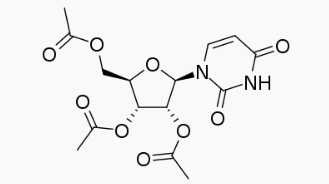
| |
Uridine triacetate
| |
| Systematic (IUPAC) name | |
| ? | |
| Identifiers | |
| CAS number | |
| ATC code | A16 |
| PubChem | |
| DrugBank | |
| Chemical data | |
| Formula | Template:OrganicBox atomTemplate:OrganicBox atomTemplate:OrganicBoxTemplate:OrganicBoxTemplate:OrganicBoxTemplate:OrganicBoxTemplate:OrganicBox atomTemplate:OrganicBoxTemplate:OrganicBoxTemplate:OrganicBoxTemplate:OrganicBoxTemplate:OrganicBoxTemplate:OrganicBoxTemplate:OrganicBox atomTemplate:OrganicBoxTemplate:OrganicBox atomTemplate:OrganicBoxTemplate:OrganicBoxTemplate:OrganicBox atomTemplate:OrganicBoxTemplate:OrganicBoxTemplate:OrganicBoxTemplate:OrganicBox |
| Mol. mass | ? |
| Pharmacokinetic data | |
| Bioavailability | ? |
| Metabolism | Pyrimidine catabolic pathway |
| Half life | 2-2.5 hours |
| Excretion | Renal |
| Therapeutic considerations | |
| Pregnancy cat. |
? |
| Legal status |
[[Prescription drug|Template:Unicode-only]](US) |
| Routes | Oral granules |
Mechanism of Action
Uridine triacetate is an acetylated form of uridine. Following oral administration, uridine triacetate is deacetylated by nonspecific esterases present throughout the body, yielding uridine in the circulation (Figure 1).
- Figure 1: Uridine Triacetate Conversion to Uridine

Uridine triacetate provides uridine in the systemic circulation of patients with hereditary orotic aciduria who cannot synthesize adequate quantities of uridine due to a genetic defect in uridine nucleotide synthesis.
Structure
Uridine triacetate oral granules is a pyrimidine analog indicated for uridine replacement therapy. Uridine triacetate has the chemical designation (2',3',5'-tri-O-acetyl-ß-D-ribofuranosyl)-2,4(1H,3H)-pyrimidinedione. The molecular weight is 370.3 and it has an empirical formula of C15H18N2O9. The structural formula is:
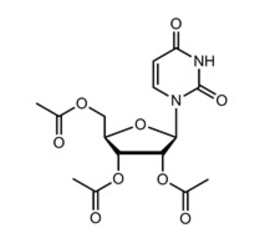
Each single-use 2 gram packet of Uridine triacetate orange-flavored oral granules (95% w/w) contains 2 grams of uridine triacetate and the following inactive ingredients: ethylcellulose (0.062 grams), Opadry Clear [proprietary dispersion of hydroxypropylmethylcellulose and Macrogol] (0.015 grams), and natural orange juice flavor (0.026 grams).
Pharmacodynamics
Hereditary orotic aciduria (uridine monophosphate synthase deficiency) is a rare congenital autosomal recessive disorder of pyrimidine metabolism caused by a defect in uridine monophosphate synthase (UMPS). The UMPS gene encodes uridine 5′monophosphate synthase, a bifunctional enzyme that catalyzes the final two steps of the de novo pyrimidine biosynthetic pathway in mammalian cells.
The defect in UMP synthase in hereditary orotic aciduria has two primary biochemical consequences. First, the blockade of de novo UMP synthesis results in a systemic deficiency of pyrimidine nucleotides, accounting for most clinical consequences of the disease. Second, orotic acid from the de novo pyrimidine pathway that cannot be converted to UMP is excreted in the urine, accounting for the common name of the disorder, orotic aciduria. Orotic acid crystals in the urine can cause episodes of obstructive uropathy.
Uridine triacetate delivers uridine into the circulation, where it can be used by essentially all cells to make uridine nucleotides, compensating for the genetic deficiency in synthesis in patients with hereditary orotic aciduria. When intracellular uridine nucleotides are restored into the normal range, overproduction of orotic acid is reduced by feedback inhibition, so that urinary excretion of orotic acid is also reduced.
Pharmacokinetics
Uridine triacetate delivers 4- to 6-fold more uridine into the systemic circulation compared to equimolar doses of uridine itself. Maximum concentrations of uridine in plasma following oral Uridine triacetate are generally achieved within 2 to 3 hours, and the half-life ranges from approximately 2 to 2.5 hours.
A study in patients with hereditary orotic aciduria included an assessment of plasma uridine pharmacokinetics in 4 patients. Three of the patients were previously treated with oral uridine. On Day 0 (baseline), these three patients received their usual daily dose of oral uridine as a single dose (150 to 200 mg/kg once daily) and on Day 1, initiated oral Uridine triacetate treatment (60 mg/kg once daily). A fourth patient was enrolled who was naïve to uridine replacement therapy. The dose of Uridine triacetate was increased on Day 116 to 120 mg/kg once daily in two patients (Patients 3 and 4) and plasma uridine concentrations were assessed on Day 160 (44 days after the dose increase).
Plasma uridine levels in all four patients are depicted in Figure 2. Pharmacokinetic parameters are summarized in Table 3. Mean exposure to plasma uridine as assessed by Cmax and AUC was greater after oral Uridine triacetate than after oral uridine (approximately 4-fold on an equiweight basis, and 6-fold on an equimolar basis), although individual differences in relative bioavailability were noted. Plasma concentrations of the uridine catabolite uracil were generally below the limit of quantitation in all patients.
- Table 3: Pharmacokinetic Parameters for Plasma Uridine
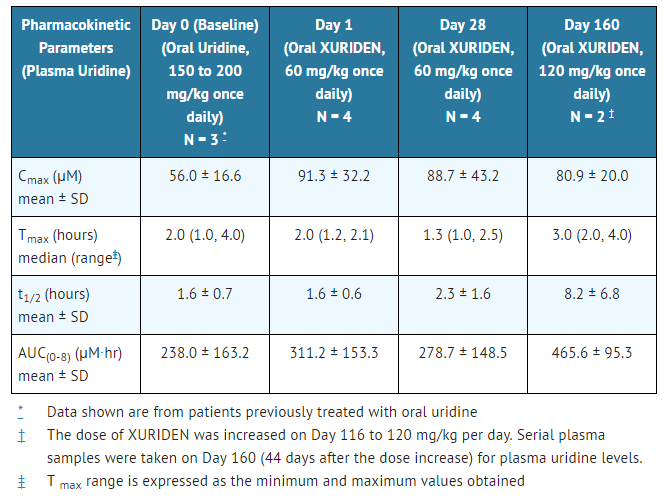
XURIDEN: Uridine triacetate's Brand name
- Figure 2 Plasma Uridine Following Oral Administration of Uridine (Day 0) or Uridine triacetate (Days 1, 28 and 160) in Patients with Hereditary Orotic Aciduria
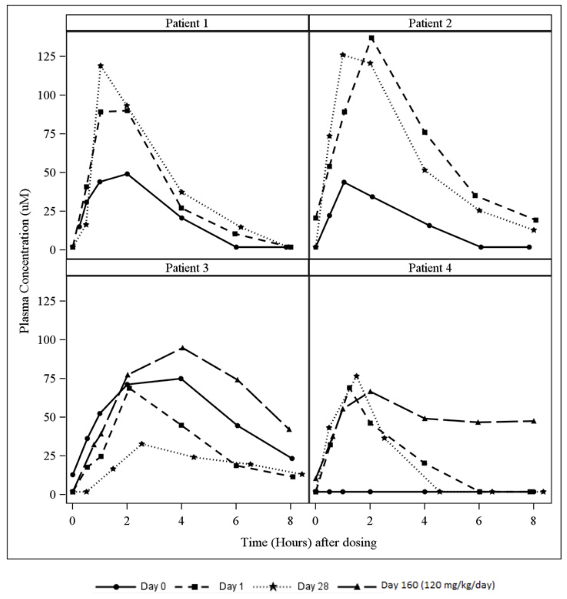
- Food Effect on Uridine PK: A study in healthy adult subjects receiving a slightly different formulation of uridine triacetate granules (6 gram dose) under fed and fasted conditions showed no difference in the overall rate and extent of uridine exposure.
Circulating uridine is taken up into mammalian cells via specific nucleoside transporters, and also crosses the blood brain barrier.
Excretion
Uridine can be excreted via the kidneys, but is also metabolized by normal pyrimidine catabolic pathways present in most tissues.
Drug Interaction Studies
In vitro enzyme inhibition data did not reveal meaningful inhibitory effects of uridine triacetate or uridine on CYP3A4, CYP1A2, CYP2C8, CYP2C9, CYP2C19, CYP2D6, and CYP2E1. In vitro enzyme induction data did not reveal an inducing effect of uridine triacetate or uridine on CYP1A2, CYP2B6, or CYP3A4.
In vitro data showed that uridine triacetate was a weak substrate for P-glycoprotein. Uridine triacetate inhibited the transport of a known P-glycoprotein substrate, digoxin, with an IC50 of 344 µM. Due to the potential for high local (gut) concentrations of the drug after dosing, the interaction of Uridine triacetate with orally administered P-gp substrate drugs cannot be ruled out.
In vivo data in humans are not available.
Nonclinical Toxicology
Carcinogenesis, Mutagenesis, Impairment of Fertility
Long-term studies in animals have not been performed to evaluate the carcinogenic potential of uridine triacetate.
Uridine triacetate was not genotoxic in the Ames test, the mouse lymphoma assay and the mouse micronucleus test.
Orally administered uridine triacetate did not affect fertility or general reproductive performance in male and female rats at doses up to 2000 mg/kg per day (about 2.7 times the maximum recommend human dose (MRHD) of 120 mg/kg per day on a body surface area basis).
Clinical Studies
The efficacy of Uridine triacetate was evaluated in an open-label study in 4 patients with hereditary orotic aciduria (3 male, 1 female; age range from 3 to 19 years). Three patients were previously treated with uridine and were switched at study entry to Uridine triacetate. All patients were administered Uridine triacetate orally at a daily dosage of 60 mg/kg once daily. The study duration was 6 weeks.
The study assessed changes in the patients' pre-specified hematologic parameters during the 6-week trial period. The pre-specified hematologic parameters were: neutrophil count and percent neutrophils (Patient 1), white blood cell count (Patient 2), and mean corpuscular volume (Patients 3 and 4).
For patients switched from oral uridine to oral Uridine triacetate (Patients 1, 2, and 3), the primary endpoint was stability of the hematologic parameter; for the treatment-naïve patient (Patient 4), the primary endpoint was improvement of the hematologic parameter. Secondary endpoints were urine orotic acid and orotidine levels, and growth (height and weight) for all patients.
After six weeks of treatment, Patients 1 and 3 met the pre-specified criteria for stability of the hematologic parameter. When Patient 2 was switched from uridine to Uridine triacetate treatment, the pre-specified criteria for white blood cell count remained stable; however documentation of a low white blood cell count prior to uridine initiation was not available. Patient 4 did not meet the pre-specified endpoint of improvement of the hematologic parameter.
Table 4 summarizes the primary efficacy results.
- Table 4: Primary Efficacy Results for Study 1
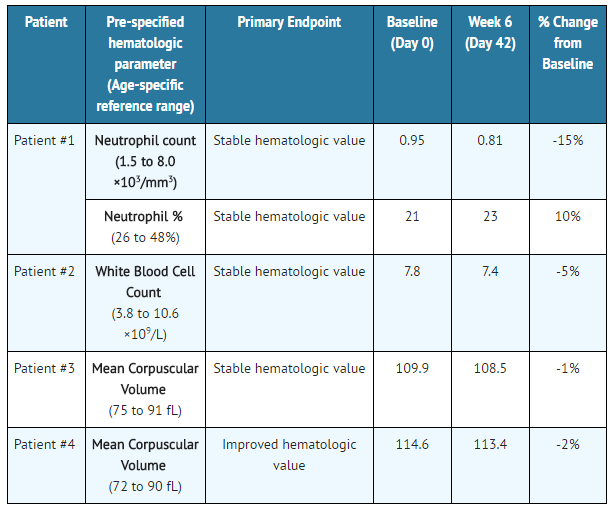
At baseline, three patients had normal urine orotic acid levels and all four patients had normal urine orotidine levels. Three patients who had achieved normal urine orotic acid levels when they were treated with uridine maintained normal levels 6 weeks after transitioning to Uridine triacetate. All four patients had normal urine orotidine levels at baseline which remained stable after 6 weeks of treatment with Uridine triacetate.
During an extension phase of the trial, patients continued to receive Uridine triacetate. Dosing during the extension phase ranged from 60 mg/kg to 120 mg/kg once daily. After 6 months of treatment, Patient #1's neutrophil count and neutrophil percent values normalized; hematologic parameters for the other three patients remained stable. Orotic acid and orotidine levels also remained stable for all four patients.
The treatment effect of Uridine triacetate on growth was assessed in the three pediatric patients (Patients 1, 3, and 4). At baseline, weight and height measurements were at or below the lower limit of normal for age (below 5th percentile for age) for Patients 1 and 4; height and weight measurements were within the normal range for age for Patient 3. After 6 months of treatment, Patients 1 and 3 experienced improved weight growth, as reflected in increases in their weight-for-age percentiles and weight velocity percentiles; Patient 4's weight growth remained stable (i.e., weight percentile for age and weight velocity percentile for age was unchanged). Height growth remained stable in all three patients (i.e., height percentiles for age and height velocity percentiles for age were unchanged).
- Case reports
- Nineteen (19) case reports of patients with hereditary orotic aciduria have been documented in published literature. Eighteen (18) patients were diagnosed as infants or children between the ages of 2 months and 12 years and were treated with exogenous sources of uridine. One patient, diagnosed at age 28, was not treated with exogenous uridine.
- All 19 patients presented with significantly elevated levels of urinary orotic acid. Fifteen of 19 had abnormal hematologic parameters at presentation, including 15 with megaloblastic anemia, 8 with leukopenia and at least 2 with neutropenia. Oral administration of exogenous sources of uridine was reported to significantly improve hematologic abnormalities (megaloblastic anemia, leukopenia and neutropenia) within 2 to 3 weeks in almost all documented cases when administered in sufficient amounts. Concentrations of urinary orotic acid were significantly reduced within 1 to 2 weeks of initiating uridine replacement therapy. Some fluctuation in levels of urinary orotic acid were observed, but always at much lower levels than those reported prior to treatment. Improvements in body weight were also documented over time with continued uridine replacement therapy.
- The effects of exogenous uridine were maintained over months and years, as long as treatment continued at sufficient doses (with appropriate dose increases based on body weight increases). Most hematologic abnormalities and orotic aciduria reappeared within days up to 2 or 3 weeks when administration of uridine was stopped or the dose was reduced. If treatment was interrupted for longer periods, body weight growth receded. If absolute dosages were not adjusted adequately to compensate for body weight gains, signs and symptoms of hereditary orotic aciduria recurred.
How Supplied
Uridine triacetate orange-flavored oral granules (95% w/w) are available in single-use packets (NDC 69468-152-02) containing 2 grams of uridine triacetate in cartons of 30 packets each (NDC 69468-152-30).
Storage
Store at controlled room temperature, 25°C (77°F); excursions permitted to 15° to 30°C (59° to 86°F).
Images
Drug Images
{{#ask: Page Name::Uridine triacetate |?Pill Name |?Drug Name |?Pill Ingred |?Pill Imprint |?Pill Dosage |?Pill Color |?Pill Shape |?Pill Size (mm) |?Pill Scoring |?NDC |?Drug Author |format=template |template=DrugPageImages |mainlabel=- |sort=Pill Name }}
Package and Label Display Panel
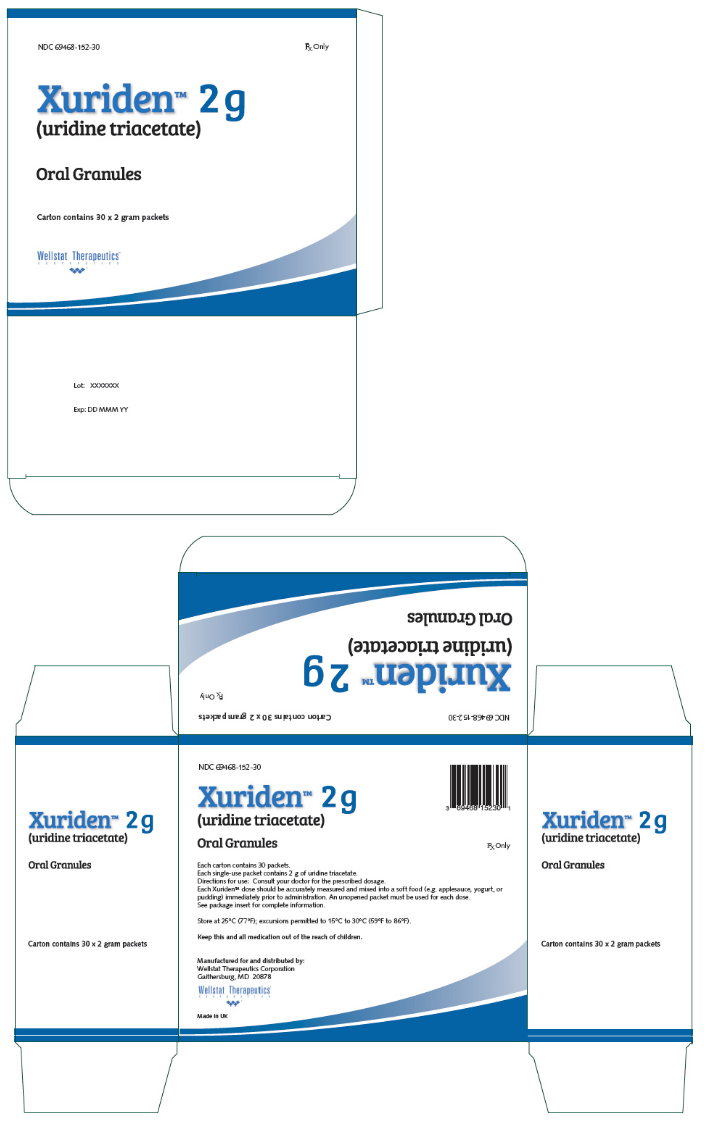
{{#ask: Label Page::Uridine triacetate |?Label Name |format=template |template=DrugLabelImages |mainlabel=- |sort=Label Page }}
Patient Counseling Information
Advise the patient or caregiver to read the FDA-approved patient labeling (Instructions for Use)
Administration
Advise the patient or caregiver:
- To measure the prescribed dose using either a scale accurate to at least 0.1 gram, or a graduated teaspoon, accurate to the fraction of the dose to be administered.
- To discard the unused portion of granules in a packet after measuring out the dose.
- That Uridine triacetate can be taken mixed in food (applesauce, pudding or yogurt) or mixed in milk or infant formula.
- That the Uridine triacetate granules should not be chewed.
INSTRUCTIONS FOR USE URIDINE TRIACETATE ORAL GRANULES
Read this Instructions for Use before you prepare Uridine triacetate for the first time, each time you get a refill, and as needed. There may be new information. This information does not take the place of talking to your healthcare provider about your or your child's medical condition or treatment. Ask your healthcare provider if you have any questions about how to mix or give a dose of Uridine triacetate the right way.
Important Information
- Take Uridine triacetate exactly as your healthcare provider tells you to.
- Your healthcare provider will prescribe the dose of Uridine triacetate depending on your body weight. Your healthcare provider will tell you the right dose to take.
- Your healthcare provider will show you how to measure the prescribed dose. The prescribed dose of Uridine triacetate can be measured using a scale or an adjustable measuring spoon.
- Your healthcare provider may change your dose if needed. Do not change the dose without first talking with your healthcare provider.
- Uridine triacetate may be taken by mixing Uridine triacetate with 3 to 4 ounces of applesauce, pudding or yogurt or may be mixed with milk or infant formula.
- Uridine triacetate mixed with applesauce, pudding or yogurt should be eaten right away. Do not save the mixed applesauce, pudding or yogurt for later use.
- Do not chew the Uridine triacetate oral granules.
For each dose of Uridine triacetate given in applesauce, pudding or yogurt, you will need the following (See FIGURE A):
- paper towels
- Uridine triacetate packet or packets containing the medicine needed for the prescribed dose
- 1 scale or 1 adjustable measuring spoon
- small spoon for stirring
- 1 small clean container (such as a small cup or bowl)
- 3 to 4 ounces of applesauce, pudding or yogurt
- 4 ounces of drinking water
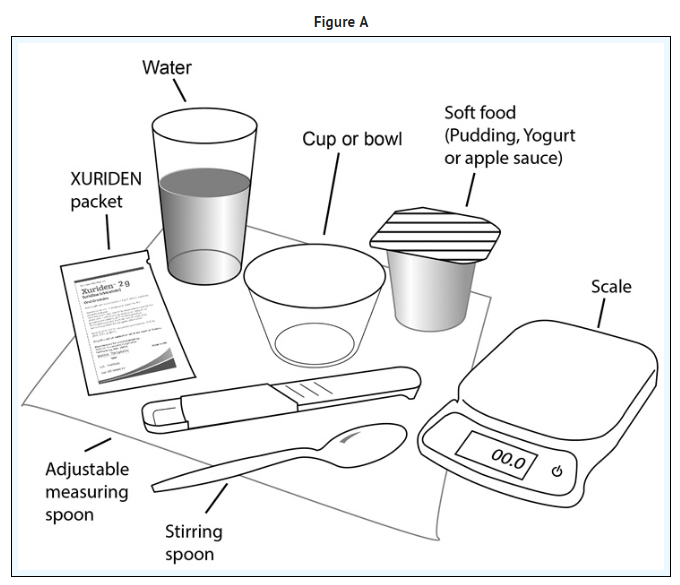
XURIDEN: Uridine triacetate's Brand name

XURIDEN: Uridine triacetate's Brand name
For each dose of Uridine triacetate given in milk or formula to children receiving up to ¾ teaspoon (2 grams of Uridine triacetate), you will need the following (See FIGURE B):
- paper towels
- Uridine triacetate packet or packets containing the medicine needed for your prescribed dose
- 1 oral dosing syringe (10mL) with a cap
- 1 scale or 1 adjustable measuring spoon
- milk or infant formula (10mL)
- 1 medicine cup (30mL)
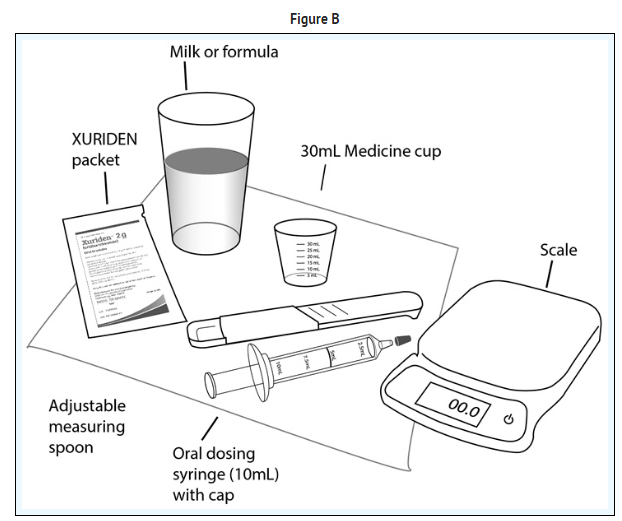
XURIDEN: Uridine triacetate's Brand name

XURIDEN: Uridine triacetate's Brand name
How should I store Uridine triacetate?
- Store Uridine triacetate at room temperature between 59° F to 86°F (15° to 30°C).
- Keep Uridine triacetate and all medicines out of the reach of children.
General information about the safe and effective use of Uridine triacetate
This Instructions for Use leaflet summarizes the most important information about Uridine triacetate. If you would like more information, talk with your healthcare provider. You can ask your healthcare provider or pharmacist for information about Uridine triacetate that is written for healthcare professionals.
What are the ingredients in Uridine triacetate?
- Active ingredient: uridine triacetate
- Inactive ingredients: ethylcellulose, hydroxypropylmethylcellulose, Macrogol, natural orange juice flavor
This Instructions for Use has been approved by the U.S. Food and Drug Administration.
Precautions with Alcohol
Alcohol-Uridine triacetate interaction has not been established. Talk to your doctor regarding the effects of taking alcohol with this medication.
Brand Names
XURIDEN™
Look-Alike Drug Names
There is limited information regarding Uridine triacetate Look-Alike Drug Names in the drug label.
Drug Shortage Status
Price
References
The contents of this FDA label are provided by the National Library of Medicine.